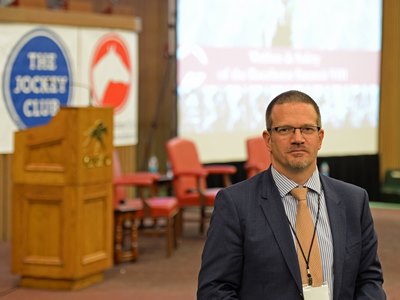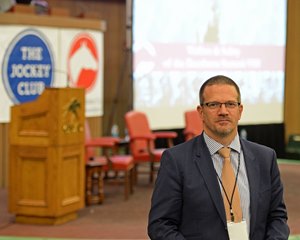EID Study: Voided Claim Rules Improve Equine Safety


Data from The Jockey Club Equine Injury Database suggests jurisdictions that have added voided claim rules are providing further protection for racehorses.
That conclusion emerged from one of a number of points of focus in the past 18 months in study of numbers generated by the EID, which tracks catastrophic injuries in horses for about 99% of race starts in the United States.
Tim Parkin, professor of veterinary epidemiology at the University of Glasgow who has studied EID numbers since the database launched in 2009, outlined his latest findings during a June 9 webinar, part of a series of discussions presented by Grayson-Jockey Club Research Foundation serving as a substitute for the 2020 Welfare and Safety of the Racehorse Summit, which was canceled because of the COVID-19 pandemic. The session also included Mary Scollay, executive director and COO of the Racing Medication and Testing Consortium, and Kristin Werner, senior counsel for The Jockey Club.
In his presentation, Parkin shared numbers that suggest voided claim rules are reducing catastrophic injuries. While the rules may vary from state to state, they place added requirements before a claim (a purchase of a horse out of a race) goes through. Claims can be voided if a horse suffers catastrophic injury during the race or suffers an injury significant enough to be placed on the vet's list.
Parkin presented numbers that show that voided claim rules, no matter how they are structured, are improving safety but that more stringent rules are providing further protection. For instance, rules that require a horse to not be placed on the vet's list post-race for the claim to go through provide more protection than rules that require only that the horse not suffer catastrophic injury during the race.
"It's clear to me that it's a really significant regulatory intervention," Parkin said. "Clearly it cannot do harm. I would encourage more tracks and jurisdictions to introduce voided claim rules as they see fit. … They are that second check on entering a horse that would be at greater risk if it did race."
Scollay said such rules intend to cause the trainer of the horse being entered in the claiming race to "self-edit," knowing that if the horse comes back unsound it's going to come back to his barn and not be sold. She said the rule provides incentive to improve decision-making to protect the horse.
Parkin focused the study on tracks that have added voided claim rules sometime between the launch of the EID in 2009 and 2019.
"These data points simply look at the risk at those individual tracks prior to the VCR (voided claim rule) and post introduction of VCR in claiming races and maiden-claiming races," Parkin said. "Certainly in claiming races there's been a very significant drop in the risk of fatal injury post-introduction of the voided claim rule. … The drop in maiden-claiming races wasn't statistically significant but was going in the right direction and there's certainly no evidence that introduction of a void claim rule can cause any harm. It's certainly not going in the wrong direction."
Other areas of attention in the past 18 months have included a closer examination of the use of shockwave therapy, the effects of racing on bute (from a study in Argentina), non-musculoskeletal fatalities, and risks involved in racing in claiming races.
Data from the EID have shown that equine fatalities during racing are multi-factorial in terms of cause and the numbers have been used to craft new approaches to address these many factors. Those efforts have led to a 23% reduction in equine fatalities since 2009, which Parkin notes is statistically significant—an already rare occurrence has been reduced further as the sport saw a record low for such incidents last year.
As Scollay put it, in 2019, 99.847% of horses safely returned to their barns after races.
"We have successfully and consistently reduced our injury occurrence," Scollay said. "We're heading in the right direction. We've been able to sustain the improvement. It's hard to tag any one event as the tipping point because there have been so many safety initiatives implemented over that period of time. At the end of the day we're doing something right and we've been able to sustain that. Our work is paying off."
Parkin said both the effort and improvements have been impressive.
"Racing gets a real bashing and we have to get this message across that over the past 10 years there's been a significant improvement," Parkin said.
